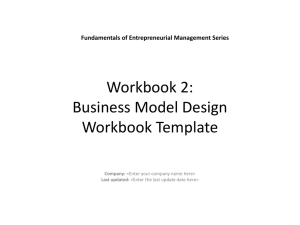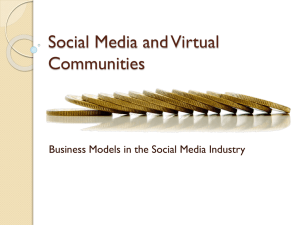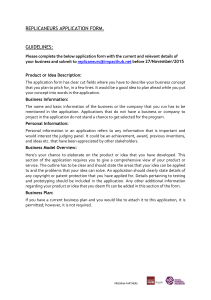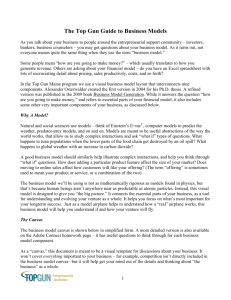Click here for the Business Canvas Explained Handout
advertisement
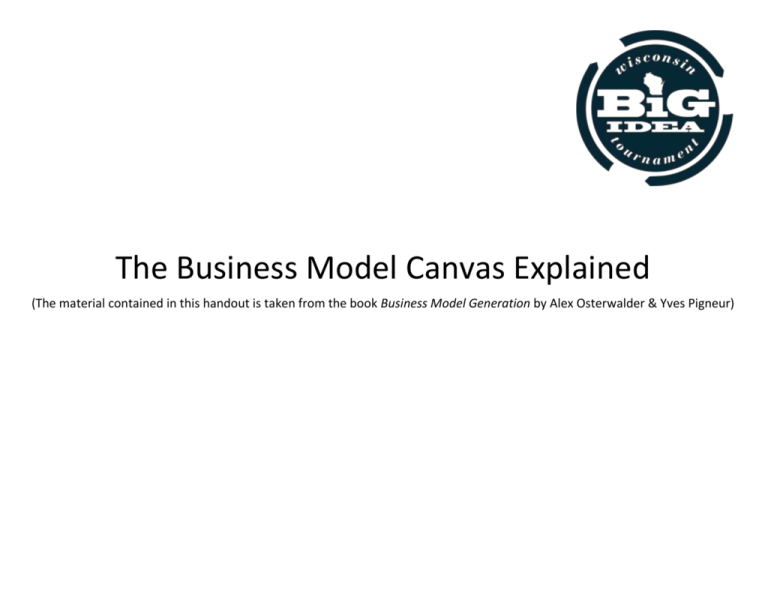
The Business Model Canvas Explained (The material contained in this handout is taken from the book Business Model Generation by Alex Osterwalder & Yves Pigneur) Customer Segments Defines the different groups of people or organizations an enterprise aims to reach and serve. Customers comprise the heart of any business model. Without (profitable) customers, no company can survive for long. In order to better satisfy customers, a company may group them into distinct segments with common needs, common behaviors, or other attributes. A business model may define one or several large or small Customer Segments. An organization must make a conscious decision about which segments to serve and which segments to ignore. Once this decision is made, a business model can be carefully designed around a strong understanding of specific customer needs. Customer groups represent separate segments if: • Their needs require and justify a distinct offer • They are reached through different Distribution Channels • They require different types of relationships • They have substantially different profitabilities • They are willing to pay for different aspects of the offer Questions to be Answered: • For whom are we creating value? • Who are our most important customers? Notes Value Propositions Describes the bundle of products and services that create value for a specific Customer Segment. The Value Proposition is the reason why customers turn to one company over another. It solves a customer problem or satisfies a customer need. Each Value Proposition consists of a selected bundle of products and/or services that caters to the requirements of a specific Customer Segment. In this sense, the Value Proposition is an aggregation, or bundle, of benefits that a company offers customers. Some Value Propositions may be innovative and represent a new or disruptive offer. Others may be similar to existing market offers, but with added features and attributes. Questions to be Answered: • What value do we deliver to the customer? • Which one of our customer’s problems are we helping to solve? Which customer needs are we satisfying? • What bundles of products and services are we offering to each Customer Segment? Notes Channels Describes how a company communicates with and reaches its Customer Segments to deliver a Value Proposition. Communication, distribution, and sales Channels comprise a company's interface with customers. Channels are customer touch points that play an important role in the customer experience. Channels serve several functions, including: • Raising awareness among customers about a company’s • products and services • Helping customers evaluate a company’s Value Proposition • Allowing customers to purchase specific products and services • Delivering a Value Proposition to customers • Providing post-purchase customer support Customer Relationships Describes the types of relationships a company establishes with specific Customer Segments. A company should clarify the type of relationship it wants to establish with each Customer Segment. Relationships can range from personal to automated. Customer relationships may be driven by the following motivations: • Customer acquisition • Customer retention Boosting sales (upselling) Questions to be Answered: • Through which Channels do our Customer Segments want to be reached? • How are we reaching them now? • How are our Channels integrated? • Which ones work best? • Which ones are most cost-efficient? How are we integrating them with customer routines? Notes Questions to be Answered: • What type of relationship does each of our Customer • Segments expect us to establish and maintain with them? • Which ones have we established? How costly are they? • How are they integrated with the rest of our business model? Notes Key Resources Describes the most important assets required to make a business model work. Every business model requires Key Resources. These resources allow an enterprise to create and offer a Value Proposition, reach markets, maintain relationships with Customer Segments, and earn revenues. Questions to be Answered: • What Key Resources do our Value Propositions require? • What Key Resources do our Distribution Channels require? • What Key Resources do our Customer Relationships require? • What Key Resources do our Revenue Streams require? Notes Different Key Resources are needed depending on the type of business model. A microchip manufacturer requires capital-intensive production facilities, whereas a microchip designer focuses more on human resources. Key resources can be physical, financial, intellectual, or human. Key resources can be owned or leased by the company or acquired from key partners. Key Activities Describes the most important things a company must do to make its business model work. Every business model calls for a number of Key Activities. These are the most important actions a company must take to operate successfully. Like Key Resources, they are required to create and offer a Value Proposition, reach markets, maintain Customer Relationships, and earn revenues. And like Key Resources, Key Activities differ depending on business model type. For software maker Microsoft, Key Activities include software development. For PC manufacturer Dell, Key Activities include supply chain management. For consultancy McKinsey, Key Activities include problem solving. Key Partnerships Describes the network of suppliers and partners that make the business model work. Companies forge partnerships for many reasons, and partnerships are becoming a cornerstone of many business models. Companies create alliances to optimize their business models, reduce risk, or acquire resources. Questions to be Answered: • What Key Activities do our Value Propositions require? • Our Distribution Channels? • Customer Relationships? • Revenue streams? Notes Questions to be Answered: • Who are our Key Partners? • Who are our key suppliers? • Which Key Resources are we acquiring from partners? • Which Key Activities do partners perform? Notes We can distinguish between four different types of partnerships: • Strategic alliances between non-competitors • Competition: strategic partnerships between competitors • Joint ventures to develop new businesses Cost Structure Describes all costs incurred to operate a business model. This building block describes the most important costs incurred while operating under a particular business model. Creating and delivering value, maintaining Customer Relationships, and generating revenue all incur costs. Such costs can be calculated relatively easily after defining Key Resources, Key Activities, and Key Partnerships. Some business models, though, are more cost-driven than others. So-called “no frills” airlines, for instance, have built business models entirely around low Cost Structures. Revenue Streams Represents the cash a company generates from each Customer Segment (costs must be subtracted from revenues to create earnings). If customers comprise the heart of a business model, Revenue Streams are its arteries. A company must ask itself, For what value is each Customer Segment truly willing to pay? Successfully answering that question allows the firm to generate one or more Revenue Streams from each Customer Segment. Each Revenue Stream may have different pricing mechanisms, such as fixed list prices, bargaining, auctioning, market dependent, volume dependent, or yield management. A business model can involve two different types of Revenue Streams: • Transaction revenues resulting from one-time customer payments • Recurring revenues resulting from ongoing payments to either deliver a Value Proposition to customers or provide post-purchase customer support Questions to be Answered: • What are the most important costs inherent in our business model? • Which Key Resources are most expensive? • Which Key Activities are most expensive? Notes Questions to be Answered: • For what value are our customers really willing to pay? • For what do they currently pay? • How are they currently paying? • How would they prefer to pay? • How much does each Revenue Stream contribute to overall revenues? Notes

